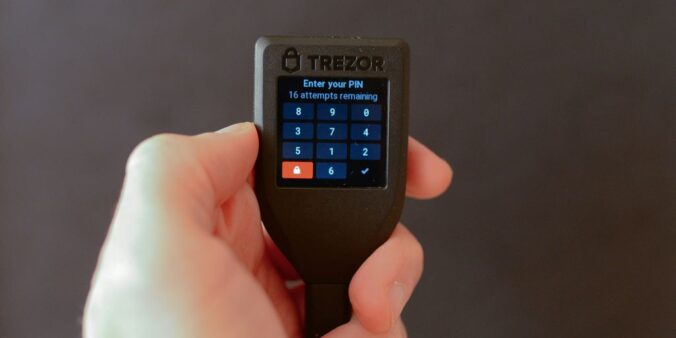As cryptocurrencies become increasingly popular, securing digital assets has never been more crucial. One of the most important decisions you’ll make is choosing between a hot wallet and a cold wallet for storing your crypto. Each type of wallet offers distinct advantages and disadvantages, and understanding these can help you make an informed choice that aligns with your needs and security concerns.
Key Takeaways
- Hot wallets are connected to the internet, making them convenient for frequent transactions but more vulnerable to online attacks.
- Cold wallets store your crypto keys offline, offering higher security but less convenience for regular transactions.
- Choosing between a hot wallet and a cold wallet depends on your individual needs, such as the frequency of transactions and your security requirements.
- Combining both hot and cold wallets can offer a balanced approach, leveraging the convenience of hot wallets and the security of cold wallets.
- It’s essential to consider factors like ease of use, security features, and your specific use cases when selecting a crypto wallet.
Understanding Cryptocurrency Wallets

Cryptocurrency wallets are an essential tool for anyone involved in cryptocurrencies and other digital assets. However, understanding how to distinguish between the different options on crypto wallets is essential to deciding which will work best for a particular user’s needs. As well as knowing the advantages and disadvantages of hot wallets and cold wallets, users should do their due diligence with the multitude of crypto wallet hardware available and decide which will be most useful for their specific requirements.
What Are Hot Wallets?

Hot wallets are digital cryptocurrency storage systems that are continuously connected to the internet, providing users with easy accessibility and convenience. They can come in various forms, such as mobile, desktop, or web-based wallets, and are user-friendly, facilitating the smooth transfer of cryptocurrencies.
What Are Cold Wallets?
Features of Cold Wallets
Cold wallets are a type of crypto wallet that is not connected to the internet. They are often physical devices, like a thumb drive, that store your private keys offline. This offline storage makes cold wallets less vulnerable to online attacks, providing a higher level of security for your cryptocurrencies. Cold wallets offer an additional layer of security to protect a user’s assets. These wallets usually come as hardware devices that look like USB sticks and cost between $50 and $200. Hardware and paper wallets are examples of cold storage wallets.
Advantages of Using Cold Wallets
- Enhanced Security: Cold wallets are completely disconnected from the internet, making them less susceptible to hacking.
- Offline Storage: By keeping your keys offline, cold wallets protect you from potentially malicious smart contracts.
- Long-term Storage: Cold wallets act as a vault for the bulk of your crypto, isolating it from all potential risks. You can think of it as a “savings” account, where you keep the majority of your funds but don’t actively transact.
Disadvantages of Cold Wallets
- Accessibility: Since cold wallets are offline, accessing your funds can be less convenient compared to hot wallets.
- Cost: Cold wallets usually come as hardware devices that can cost between $50 and $200.
- Complexity: Setting up and using a cold wallet can be more complex, especially for beginners.
Cold wallets, a crypto wallet, are digital cryptocurrency storage on a platform not connected to the internet, protecting your keys from theft.
Security Comparison: Hot Wallets vs. Cold Wallets
Online Vulnerabilities of Hot Wallets
Hot wallets, being typically connected to the internet, offer ease of use and accessibility. However, their frequent online presence makes them more vulnerable to online attacks. Cold wallets, while secure, are less user-friendly for everyday transactions. This is because accessing funds stored in a cold wallet typically involves more steps, such as connecting the device to a computer and entering a PIN.
Offline Security of Cold Wallets
Cold wallets offer greater security compared to hot wallets due to their offline nature. With a cold wallet, you have complete control over your private and public keys, reducing the risk of online vulnerabilities associated with hot wallets. This makes cold wallets an ideal choice for long-term storage of large amounts of cryptocurrency.
Risk Management Strategies
To mitigate the risks associated with both types of wallets, consider the following strategies:
- Use a combination of hot and cold wallets to balance security and accessibility.
- Regularly update your hot wallet software to protect against the latest threats.
- Store the majority of your funds in a cold wallet and keep only a small amount in a hot wallet for daily transactions.
- Enable two-factor authentication (2FA) on your hot wallet for an added layer of security.
Balancing the use of hot and cold wallets can provide both security and convenience, ensuring that your cryptocurrency is protected while remaining accessible for everyday use.
Choosing the Right Wallet for Your Needs

When selecting a cryptocurrency wallet, the right type of wallet for you depends on how much crypto you hold, your security preferences, and how easily accessible you need your funds to be. Both hot and cold wallets protect your public and private keys, which are essential for authorizing your crypto transactions. However, the choice between a hot and a cold wallet depends on your individual needs and preferences.
Factors to Consider
When choosing between hot and cold wallets, consider the following factors:
- Security: Cold wallets offer higher security as they are offline, while hot wallets are more vulnerable to online threats.
- Accessibility: Hot wallets provide easier access to your funds, making them suitable for frequent transactions.
- Cost: Hot wallets are usually free, whereas cold wallets may require an initial investment in hardware.
- Convenience: Hot wallets are more convenient for daily use, while cold wallets are better for long-term storage.
Use Cases for Hot Wallets
Hot wallets are ideal for users who:
- Frequently transact with cryptocurrencies.
- Need quick and easy access to their funds.
- Prefer a user-friendly interface.
Use Cases for Cold Wallets
Cold wallets are suitable for users who:
- Prioritize security over convenience.
- Plan to hold a significant amount of cryptocurrency for the long term.
- Are willing to invest in hardware for added security.
When storing your crypto, you want to keep it safe while striking the right balance between functionality and security. The choice between a hot and a cold wallet depends on your individual needs and preferences. If you frequently transact with cryptocurrencies, a hot wallet may be more suitable for you due to its convenience. However, if you’re looking for long-term storage and higher security, a cold wallet would be a better choice.
Combining Hot and Cold Wallets

Benefits of a Hybrid Approach
Combining hot and cold wallets allows users to enjoy the convenience of hot wallets while benefiting from the enhanced security of cold wallets. This hybrid approach ensures that you can perform regular transactions with ease using a hot wallet, while storing larger amounts of cryptocurrencies securely in a cold wallet. This strategy is particularly useful for managing multiple crypto wallets efficiently in 2024.
How to Implement a Combined Strategy
- Segregate Funds: Allocate a small portion of your cryptocurrency holdings to a hot wallet for daily transactions and keep the majority in a cold wallet for long-term storage.
- Regular Transfers: Periodically transfer excess funds from your hot wallet to your cold wallet to minimize exposure to online threats.
- Backup and Recovery: Ensure you have a robust backup and recovery plan for both types of wallets to prevent loss of access.
- Security Measures: Implement additional security measures such as two-factor authentication (2FA) for your hot wallet and physical security for your cold wallet.
Examples of Hybrid Wallet Solutions
- Exchange Account Hot Wallet + Hardware Cold Wallet: Use an exchange account for trading and a hardware wallet for storing large amounts of cryptocurrencies.
- Mobile Hot Wallet + Paper Cold Wallet: Utilize a mobile wallet for quick access and transactions, while keeping a paper wallet for long-term storage.
- Software Hot Wallet + Solana Cold Wallet: Combine a software wallet for daily use with a Solana cold wallet for enhanced security.
A hybrid approach to managing your crypto assets can provide a balance between ease of use and security, making it an ideal strategy for both novice and experienced users.
Combining hot and cold wallets offers a balanced approach to cryptocurrency security and accessibility. By leveraging the strengths of both wallet types, you can enjoy the convenience of hot wallets for daily transactions and the robust security of cold wallets for long-term storage. To learn more about optimizing your crypto strategy, visit our website.
Conclusion
In the realm of cryptocurrency storage, the choice between hot wallets and cold wallets hinges on your individual needs and preferences. Hot wallets offer the convenience of quick access and ease of transactions, making them ideal for frequent traders. However, this convenience comes at the cost of increased vulnerability to online threats. On the other hand, cold wallets provide a higher level of security by keeping your private keys offline, making them suitable for long-term storage and safeguarding significant amounts of cryptocurrency. Ultimately, many users find that a combination of both hot and cold wallets offers a balanced approach, leveraging the strengths of each to meet their specific requirements. By understanding the key differences and benefits of each type of wallet, you can make an informed decision that aligns with your crypto storage strategy.
Frequently Asked Questions
What is the main difference between hot wallets and cold wallets?
Hot wallets are connected to the internet, making them more convenient for frequent transactions but also more susceptible to online attacks. Cold wallets, on the other hand, are offline, offering greater security but less convenience.
Which type of wallet is more secure: hot or cold?
Cold wallets are generally more secure than hot wallets because they are not connected to the internet, which reduces the risk of online vulnerabilities and hacking.
Can I use both a hot wallet and a cold wallet?
Yes, you can use both types of wallets. Many users opt for a hybrid approach, using a hot wallet for frequent transactions and a cold wallet for long-term storage of larger amounts of cryptocurrency.
What are the advantages of using a hot wallet?
Hot wallets offer ease of access and convenience, making them ideal for frequent transactions and day-to-day use. They are usually free and easy to set up.
What are the disadvantages of using a cold wallet?
Cold wallets can be less convenient for frequent transactions as they require manual connection to the internet for transfers. They may also come with a cost, such as purchasing a hardware wallet.
How do I choose the right wallet for my needs?
The choice between a hot and cold wallet depends on your individual needs and preferences. If you frequently transact with cryptocurrencies, a hot wallet may be more suitable. For long-term storage and higher security, a cold wallet is a better choice.



Leave a Reply